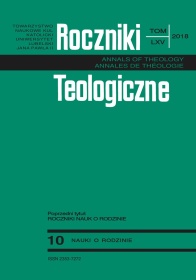Sense of Security in Males Addicted to the Internet
Abstrakt
Poczucie bezpieczeństwa u mężczyzn uzależnionych od Internetu
Celem artykułu jest przedstawienie i omówienie wyników badań nad grupą mężczyzn uzależnionych od Internetu w kontekście poczucia bezpieczeństwa. Rosnące zainteresowanie problematyką poczucia bezpieczeństwa, zarówno w perspektywie społeczno-kulturowej, jak psychologicznej, znajduje wyraz również w pojawieniu się badań nad poczuciem bezpieczeństwa osób wysoko zagrożonych uzależnieniem od Internetu. W Polsce, jak dotychczas, brakuje tego typu badań. Ich realizacja, rozpowszechnianie, jak i refleksja nad nimi, wydaje się mieć niezwykle istotne znaczenie ze względu na szerokie implikacje praktyczne – w obszarze relacji terapeutycznej, procesu zdrowienia, profilaktyki, jak również pogłębionego rozumienia pacjenta uzależnionego od Internetu.
Analizie interpretacyjnej poddano wyniki 136 respondentów, w tym: mężczyzn uzależnionych od Internetu oraz nieuzależnionych od Internetu, w wieku od 18-39 lat. W badaniach uczestniczyli sami mężczyźni.
Metoda. W badaniach wykorzystano Kwestionariusz Poczucia Bezpieczeństwa i Prężności Osobowej (KPB-PO) autorstwa Zenona Uchnasta i Test Uzależnienia od Internetu K. Young (IAT).
Wyniki. Istnieją różnice w poziomie poczucia bezpieczeństwa u mężczyzn uzależnionych i nieuzależnionych od Internetu. Rozwijanie poczucia bezpieczeństwa może przyczynić się do poprawy funkcjonowania osób uzależnionych od Internetu.
Bibliografia
Andrzejewska, Anna. Children and Adolescents in the Net of Real and Virtual Threats. Theoretical and Empirical Aspects. Warsaw: Difin, 2014.
Armstrong, Lynette, James G. Phillips, and Lauren L. Saling. „Potential Determinants of Heavier Internet Usage.” The International Journal of Human-Computer Studies 53(2000), 4: 537-50.
Brzeziński, Jerzy. Metodologiczne i psychologiczne wyznaczniki procesu badawczego w psychologii. Poznań: Wydawnictwo Uniwersytetu im. Adama Mickiewicza, 1978.
Chen, Sze Hua, and Chau Chiung. “A Review of the Research on Internet Addiction.” Educational Psychology Review 17(1999), 4: 363-388.
Eichenberg, Christiane, Schott Markus, Decker Oliver, and Brigitte Sindelar. “Attachment Style and Internet Addiction: An Online Survey.” Journal of Medical Internet Research 19(2017), 5: 170-78.
Horney, Karen. The Neurotic Personality of Our Time. Warsaw: Dom Wydawniczy REBIS, 1999.
Jakubik, Andrzej. “Internet Addition Syndrome.” Studia Psychologica UKSW 3(2002): 133-42.
Jakubik, Andrzej, Justyna Popławska. “Internet Addition Syndrome.” Studia Psychologica 4(2002): 123-31.
Kaliszewska, Katarzyna. Excessive Internet Use. Psychological Characteristics. Poznań: UAM, 2010.
Kowalski, Radosław. “Internet Addiction: Truth, Circumstantial Evidence or Fiction?” Wychowanie na co dzień 9(2005): 4-8.
Krzyżak-Szymańska, Ewa, Andrzej, Szymański. Preventing New Addictions among Children and Adolescents. Katowice: Górnośląska Wyższa Szkoła Handlowa im. Wojciecha Korfantego, 2013.
Kuss, Daria J., Olatz Lopez-Fernandez. “Internet Addiction and Problematic Internet Use: A Systematic Review of Clinical Research.” World Journal of Psychiatry 6(2016), 1: 143-76.
Maslow, Abraham. Manual for the Security-Insecurity Inventory. Palo Alto: CA: Consulting Psychologists Press, 1952.
Maslow, Abraham. Toward a Psychology of Being. Warsaw: PAX, 1986.
Maslow, Abraham. “A Theory of Human Motivation.” In Motivation and Personality. Edited by Abraham Maslow. Warsaw: PAX, 1990.
Poprawa, Ryszard. “Problematic Use of the Internet − Symptoms and Method of Diagnosis. Research among Adolescents,” Psychology of Quality of Life 11(2012), 1: 57-82.
Reber, Arthur S. Dictionary of Psychology. London: Penguin Books, 1985.
Shubnikova, Ekaterina G., Anvar N., Khuziakhmetov, and Daria P. Khanolainen. “Internet-Addiction of Adolescents: Diagnostic Problems and Pedagogical Prevention in the Educational Environment.” Eurasia Journal of Mathematics, Science and Technology Education 13(2017), 8: 5261-71.
Uchnast, Zenon. “The Concept of Man as Understood by Humanistic Psychologists.” Częstochowskie Studia Teologiczne 6(1979): 461-77.
Uchnast, Zenon. “The Method of Measuring the Sense of Security.” In Lectures on Psychology at the Catholic University of Lublin. Edited by Zenon Uchnast, Tomasz Witkowski. Lublin: RW KUL, 1991.
Ulman, Piotr. „Social and Family Determinants of Addictions in Children and Young People.” Fides et Ratio 8(2011), 4: 74-86.
Walc, Wiesława. Addictions among Children and Young People: Selected Problems. Rzeszów: Wydawnictwo Uniwersytetu Rzeszowskiego, 2016.
Woronowicz, Bohdan T. Addictions and their Treatment: Full Disclosure. Warsaw: IPiN, 2001.
Young, Kimberly, Robert Rodgers. “The Relationship between Depression and Internet Addiction.” CyberPsychology and Behavior 1(1998), 1: 25-8.
Young, Kimberly. ”Psychology of Computer Use: XL. Addictive Use of the Internet: a Case that Breaks the Stereotype.” Psychological Report 79(1996): 899-902.
Young, Kimberly. “Internet Addiction: A New Clinical Phenomenon and Its Consequences.” American Behavioral Scientist 48(2004), 4: 402-15.
Young, Kimberly. “Technology is Changing the Nature of Problems People are Having as well as how We Treat Them”. In Treatment Outcomes with Internet Addicts. Published in CyberPsychology&Behavior,2007,Vol.10,No.5;pp.671-679. Last modified April 14, 2018; http://www.netaddiction.com/articles/Treatment.pdf
Copyright (c) 2018 Roczniki Teologiczne

Utwór dostępny jest na licencji Creative Commons Uznanie autorstwa – Użycie niekomercyjne – Bez utworów zależnych 4.0 Międzynarodowe.





